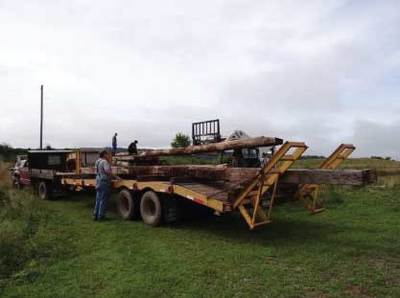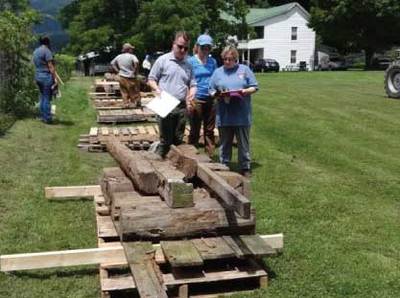|
By Kelli Shapiro, PhD I’m not an outdoorsy person, and my level of physical activity is typically so low that I would barely consider a third-floor apartment when I moved to Morgantown last year. That being the case, although I love architecture, the built environment, and historic preservation, I’ve always greatly preferred the type of preservation activities in which I could participate from the comfort of an office, museum, or archive. Thankfully (from my perspective), that has primarily been the situation during my past year of service as PAWV’s Preserve WV AmeriCorps member. I’ve been proud of my efforts doing historical research, writing press releases, updating webpages and social media, creating PowerPoint presentations, and helping the organization apply for grants – among many other activities. The Preserve WV AmeriCorps program requires all its members to participate in several hands-on service days, though, as well as to each organize their own service project – and those have forced me to come out from behind my keyboard (to my benefit, I’ll admit). When the Preserve WV member at Main Street Ripley, Ashley Donohew, organized a painting day at Ripley’s historic Alpine Theatre, it was literally the first time I’ve ever painted a wall. I had no idea how sore I would be afterward – or how much of a sense of accomplishment I (and the other AmeriCorps members who participated) would feel, standing inside that bright, freshly painted lobby and auditorium. The same was true at the service day that Preserve WV member Stephanie Wright held at Wheeling National Heritage Area’s Blue Church, where I learned how to restore stained glass windows. As I pulled old lead from a wooden frame, scraped years of dirt and paint from pieces of colored glass, and placed the pieces on a numbered drawing for later reinstallation, yes, I did worry a bit about the possibility of getting cuts – not to mention lead poisoning. But I also really enjoyed watching the shine return and the original color reappear in those glass pieces, and then imagining how the windows upon which we all were working would gleam once restored to their rightful place on the former church’s wall. Of course, since they took place indoors in clean, climate-controlled settings, those hands-on service projects were much more in my wheelhouse than others might have been. Still, despite its outdoor setting, I was nonetheless looking forward to helping with a historic cemetery survey (partially because I had been the Teaching Assistant for a college course on gravestones and burial grounds). It was organized by the Buckhannon Historic Landmarks Commission’s Christina Rieth as a service day through our frequent partner, the Appalachian Forest Heritage Area (AFHA) AmeriCorps program, and Preserve WV members were invited. Unfortunately, the first survey attempt was derailed by an unexpected springtime snowstorm, and then the rescheduled service day was cancelled due to a day-long deluge. With that situation in mind, when planning my own service project during the summer at one of PAWV’s Endangered Properties, I worked with the historic site’s steward to come up with two possible weekends – a best-case scenario for good weather, and another in case of a rain delay. We had barely finalized those dates when West Virginia’s horrific 1000-year flood occurred. Did I mention that the site in question, Williamsburg’s 1770s McCoy Fort, happened to be in Greenbrier County? Following some concerned emails to site steward Carolyn Stephens, I was relieved to learn that both the disassembled log fort and the Williamsburg District Historical Foundation – to the grounds of which the fort’s logs were going to be moved for future reassembly – had been left untouched by the nearby severe flooding. My service project to move and document the historic logs was still on! I felt at home with the computer-based portion of organizing the 2-day event. Sending out requests for Preserve WV, AFHA, and other volunteers, and figuring out the logistics of housing and feeding them, etc. – well, that was the easy part. I was also comfortable with the idea of documenting the logs; that sounded very doable for someone not accustomed to hard labor. But although local farmers were going to use their heavy equipment to move the logs from the fort’s original land to the foundation’s museum, some physical work would still need to be done. Carolyn asked me to tell everyone to bring their work boots and work gloves – a useful reminder, since it might not have even occurred to me, having never needed such things before. I then had to venture out into the unknown world of sporting goods and hardware stores (discovering how difficult it can be to find steel-toed work shoes in women’s sizes). Finally, on Saturday, July 16th, seven Preserve WV and AFHA members, Carolyn and her husband Pete, several other volunteering farmers, and two friendly pet dogs all descended upon the foundation museum’s property. While the farmers used forklifts and flatbed trailers to move the logs down the road from the original McCoy Fort site, we made donated lumber into pallets; stacked logs onto them (separated by type – wall, floor, etc.); and measured, photographed, and detailed the condition of each of those individual, numbered logs.
Over the course of the two days, during various breaks (forced by rain, thunder, hunger, or just exhaustion), we enjoyed relaxing on the porch of the museum, a reused historic house. There, we were able to relax – eating the delicious food Carolyn’s family and the foundation members provided, petting the dogs, and looking out with satisfaction at our ever-growing piles of moved, documented logs. More logs kept arriving, though, and I feared that we would have to leave before finishing moving and documenting all of them. By Sunday afternoon, though, my worries were allayed; we were finally done. Of course, having pallets full of logs is not quite the same as having a reconstructed building, so our feeling of success was that of completing a key step in a much longer, harder process. As for the next part, when that time comes for the Williamsburg District Historical Foundation, they’ll know that PAWV and its Preserve WV AmeriCorps members will be happy to help. I’m prepared; I already have my work boots! Comments are closed.
|
Preserve WV StoriesCategories
All
Archives
August 2023
|
Get Involved |
Programs |
Contact UsPreservation Alliance of West Virginia
421 Davis Avenue, #4 | Elkins, WV 26241 Email: [email protected] Phone: 304-345-6005 |
Organizational Partners:
© COPYRIGHT 2022 - PRESERVATION ALLIANCE OF WEST VIRGINIA. ALL RIGHTS RESERVED.









 RSS Feed
RSS Feed



